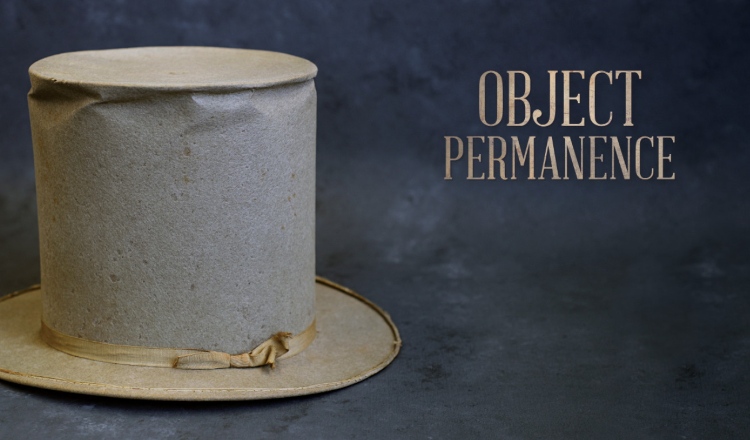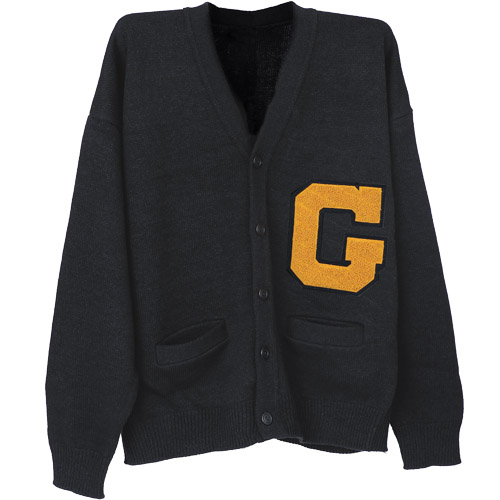
51. Gimlet Sweater
For decades, the Gimlet Leadership Honorary was synonymous with Boilermaker spirit and athletic pride, including the group’s most visible role as caretaker of the Victory Bell on the sidelines at home football games for nearly 90 years. When the organization was founded in 1922 as an honorary for fraternity men, the Gimlets would attend football practices and serve the team hot meals afterward. During the 1930s, the Gimlets helped raise money for varsity athletic teams the University couldn’t afford to fund. The Gimlet sweater became a classic look for members, often worn on Fridays and at athletic events.
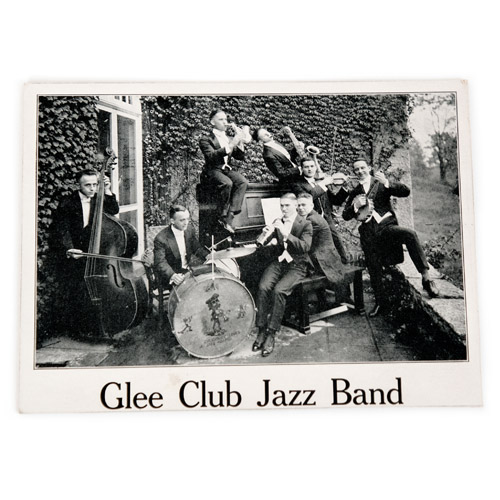
52. Glee Club Jazz Band Photo
In the 1920s, when the United States was experiencing the Jazz Age, the Purdue Varsity Glee Club developed its own Jazz Band. The 1922 Debris describes the Jazz Band as a novelty, but the prominence of the Jazz Band and the separate Saxophone Sextette at Glee Club performances showed the University’s connection to one of the iconic components of the Roaring ’20s culture.
See more Purdue Varsity Glee Club memorabilia at Bailey Hall
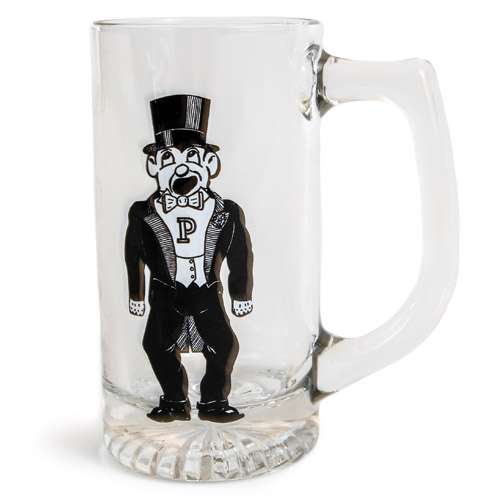
53. Glee Club Pete Mug
The symbol originated as a joke in 1954, when the Glee Club performed for the Rotary Club of North Manchester, Indiana. One of the men of the Rotary Club by the name of Slim Warren made a few modifications to the traditional Purdue Pete logo. Warren fashioned a four-foot replica of Pete wearing a top hat and tuxedo similar to the Glee Club uniform and positioned him at the side of the stage. Director Al Stewart (-S’31) and the Glee Club liked the modified version so much that they adopted Glee Club Pete as their official mascot.
See more Purdue Varsity Glee Club memorabilia at Bailey Hall.
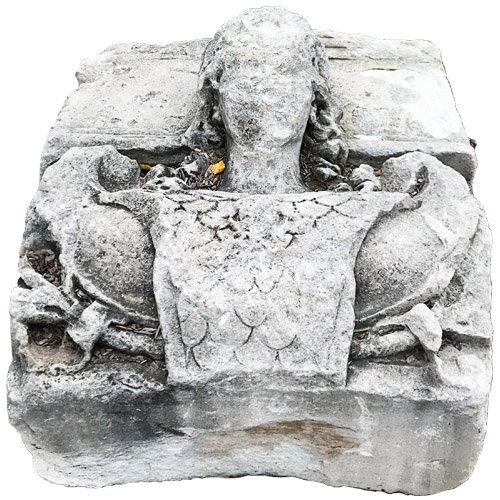
54. Goddess of War
Dedicated in 1904, Eliza Fowler Hall was a 1,300-seat auditorium that hosted many events, including commencement ceremonies and the first of Al Stewart’s legendary Christmas shows. The building was demolished in the 1950s to make way for Memorial Center. When it was torn down, a sizable sculpture of the goddess of war that appeared over the building’s entryway was discarded just north of campus in Happy Hollow Park, where it laid until it was discovered by the West Lafayette School Corporation and eventually returned to the University. To honor Eliza Fowler, the first woman to make a gift to the University and the largest gift since John Purdue, and to honor her wish that her donation be used for an auditorium, a 388-seat Fowler Hall was included in what became Stewart Center.
Eliza Fowler Hall was located on the site now occupied by Stewart Center.
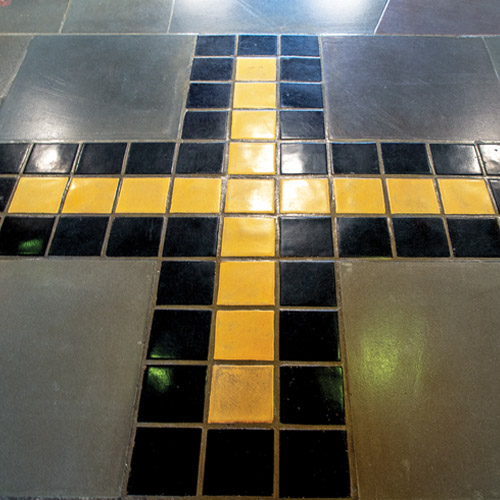
55. Gold and Black Cross
The Purdue Memorial Union was built as a permanent memorial to the 4,080 Boilermakers who served in World War I. Construction was largely funded through student and alumni donations. The gold and black cross on the floor of the Great Hall honors the 67 Purdue men who gave their lives for their country in the Great War. It has since been extended to honor all Purdue faithful who lost their lives in service to the United States of America.
Pay tribute to Purdue’s servicemen and women in the Great Hall of Purdue Memorial Union.
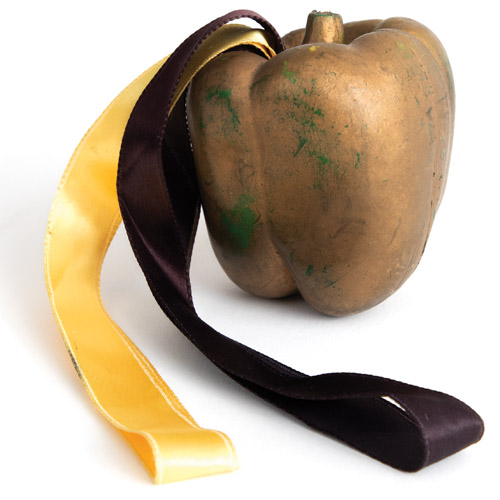
56. Gold Pepper
At the encouragement of the Gimlet Club, the men’s athletic booster group, the Purdue Mortar Board organized a junior and senior women’s athletic booster club called the Gold Peppers in 1925. The women wore gold felt beanies on their heads. They attended football and basketball games, where they sold candy and led the crowds in cheers. In the early years, a newly elected pledge wore a black pot, one gold and one black sock, and a black and gold armband. She carried a cigar box filled with candy and, dangling from a ribbon, a real green pepper gilded in gold leaf. The pledge carried the pepper for days, and often it would rot.
The gold pepper is on display in the Rudolph Room at Dauch Alumni Center.
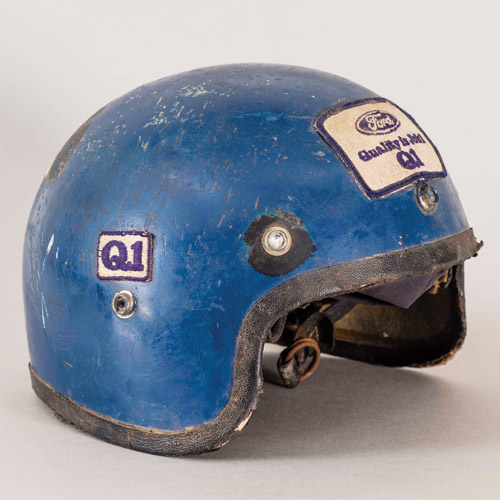
Courtesy of the Virginia Kelly Karnes Archives and Special Collections Research Center, Purdue University Libraries
57. Grand Prix Helmet
William Smith (T’66) of Kappa Delta Rho fraternity used this helmet when he competed in the Grand Prix in 1966. Smith built his kart, which won a best engineering award for its front-wheel-drive design.
Attend the Greatest Spectacle in College Racing.

58. Grateful Dead Poster
The Grateful Dead made its Indiana debut on April 18, 1969, with a boycott benefit show in the Purdue Memorial Union ballrooms. Students had begun boycotting the Purdue Memorial Union services on April 14, in response to an announced fee increase. Peace Union, the organization sponsoring the already scheduled concert, announced that proceeds would fund food and legal aid for protesting students camped out on the Memorial Mall. The power cut out during the middle of the first song “Hard to Handle.” When electricity was restored about 40 minutes later, the band returned to the stage and took it from the top. Keyboard player and vocalist Ron “Pigpen” McKernan — pictured on the poster — died three years later at age 27.
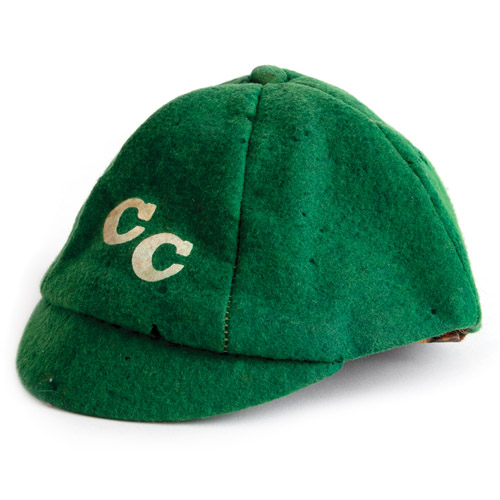
59. Green Beanie
Freshman caps were a common sight on many American college campuses into the early 1970s. The Purdue tradition began with the class of 1911. The story goes that this particular class, when it arrived in 1907, was distinctive enough that upperclassmen feared the newcomers would be mistaken for juniors or seniors. The “green” fledglings were forced to wear green beanies signifying their freshman status. Earlier versions of the caps had different colors of buttons to identify the wearer’s program of study. This later version is adorned with “CC” for Cary Club.
This green beanie is on display in the Rudolph Room at Dauch Alumni Center.
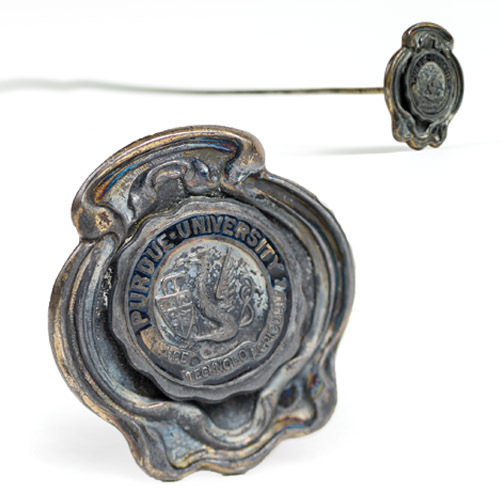
Courtesy of the Virginia Kelly Karnes Archives and Special Collections Research Center, Purdue University Libraries
60. Griffin Hatpin
This hatpin, dating from 1895, features the University’s third seal and the first to use a winged griffin, slanted shield, and uncial lettering — elements used in each successive redesign. According to the Purdue Crest by Michael Horoho (LA’93), the design was created by Abby Phelps Lytle, then head of the art department. The aesthetically pleasing design was difficult to reproduce clearly and was retired after 15 years.

